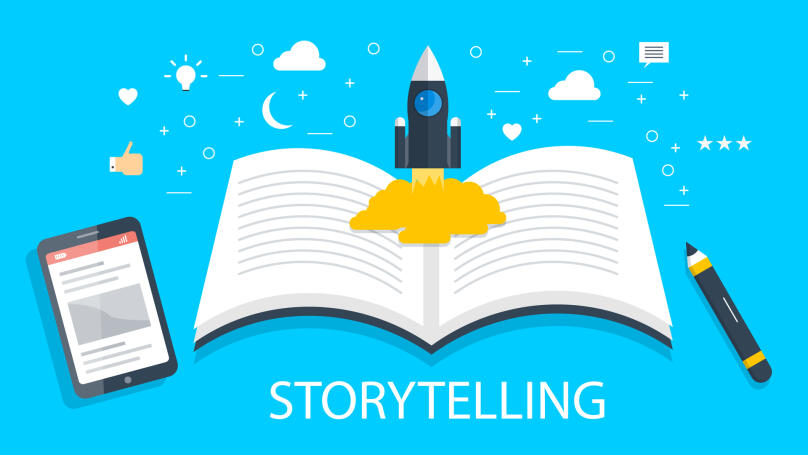Storytelling
What is storytelling?

In simple terms, storytelling is the ability to tell stories. The word storytelling is composed of two words: telling stories. You can use this skill in business, at work, and in your personal life because storytelling techniques will help make your arguments more persuasive to another person, regardless of who you are interacting with.
You can use storytelling at a product presentation, advertising, or even at a daycare: a great story works perfectly for people of all ages. Additionally, storytelling in education helps describe the material in a far more accessible way. Therefore, it is suitable for students of all ages, even for preschoolers.
Excellent storytelling takes a listener back to when history was the primary way to communicate vital information to the offsprings. The art of storytelling is to tell a story that people are going to believe and remember. Myths and legends are amongst the best examples of storytelling.
Why do we need storytelling today? In the same way as a thousand years ago, the purpose of storytelling today is to make the story more engaging and memorable. Our objectives and the way we tell stories are now changing, however. Just two centuries ago, the main method for sharing stories was reading books and going to the theatre. Currently, there are new technological tools that allow your stories to be told differently.
The tasks that we solve with the assistance of storytelling have become far more diverse. Therefore, the method of storytelling is becoming more and more extensive than perhaps it was centuries ago.
Types of storytelling

Types of storytelling are differentiated depending on how and for what purpose a story is told. You may tell stories to impress friends, sell a product, or make a good impression on a date. The storytelling approach is actively used in psychotherapy: storytelling helps people rethink their autobiography, cope with personal traumatic experiences, and find their own meaning in life.
In business, storytelling skills are used for different purposes: they can help you establish relationships with business partners, present a product effectively, or tell a story in a commercial that will increase product sales. Business stories come in different formats. Visual storytelling and digital storytelling are the most effective:
- Visual storytelling.
A way of telling a story using visual elements: images, drawings, or sketches. - Digital stories, or digital storytelling.
A way to tell a story using a digital component. What kind of story depends on what software is used to create it. This kind of storytelling could also be interactive (a story like this provides several options for the development of events, depending on the choices made by listeners or viewers.)
You can learn how to use these new technologies to promote your products by taking a course in storytelling and studying transmedia storytelling, which specialises in telling your story using new media. It's important to remember, however, that the basics of storytelling are effective, well-established communication with your audience and a well-thought-out scenario. Additionally, different storytelling techniques structure the story in different ways.
The structure of storytelling

Even the definition of storytelling might differ for various techniques. Therefore, before taking a storytelling course, it is worth understanding which techniques will be the focus of the course. Currently, the best structure techniques are:
- Monomyth.
In a monomyth, the story is built around a character who leaves their familiar world. Having overcome several obstacles, the character returns to their world and is completely transformed. Examples of stories based on this structure are easily found in films. In Hollywood films, the structure of the monomyth is frequently used. - The "Mountain" narrative structure.
The plot for this kind of story is built around a dramatic turn of events in the character's fate: the story's action is focused on the intended movement of the character towards their goal and the tragic set of circumstances that wipe out all the character's efforts. - In medias res (Latin for 'in the middle of the narrative.)
This storytelling technique starts the story from a central point, right in the middle of the action. Thanks to this, a listener or viewer can easily understand the scale and implications of the story. When using this technique, you should not give away too much information. You just need to spark the interest of the viewer or listener. - Sparklines.
For this type of storytelling structure, the essence of the story lies in the contrast between the ideal world and the real world. This works well for presentations and speeches. For example, this is precisely the technique that Martin Luther King used in his famous speech "I Have a Dream": he described his future vision of the world in which all the people of different races have equal rights, and compared his vision to the reality at the time.
This list of storytelling techniques is not exhaustive and can be continued indefinitely. When choosing a specific style for your story, it is important to consider who you want to tell it to, how you want to tell it, with what purpose, and whether using a particular technique is appropriate.
To learn storytelling is to make your words, presentations, and promotional materials more convincing. You can use different concepts and ideas for this, if you are doing it wisely. You can quickly learn how to do this by taking a training or completing a course, including an online course.























